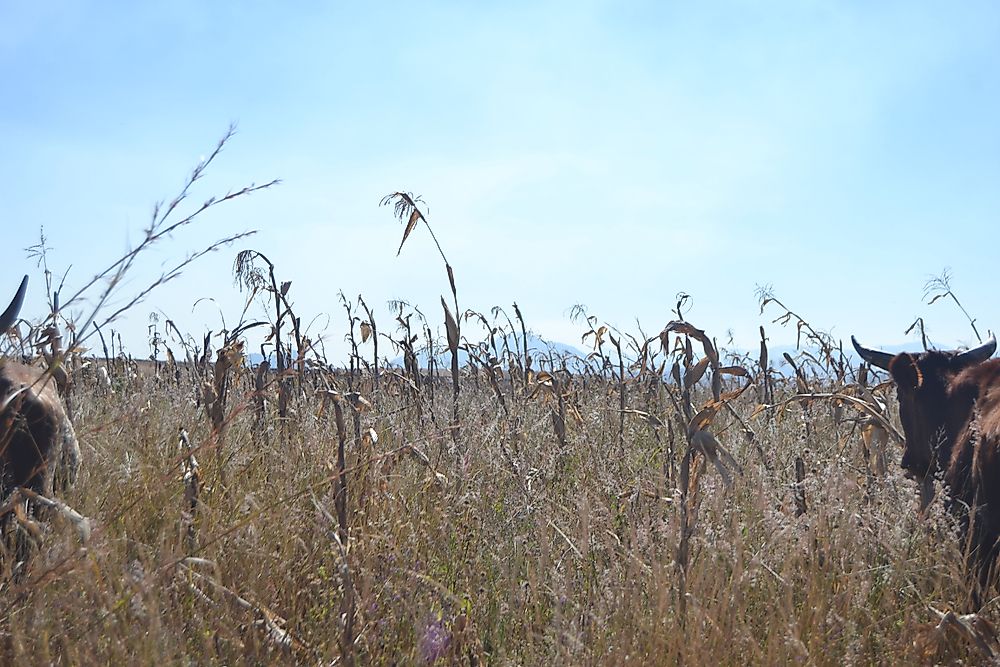The Tallest Mountains In Angola

Angola is located in southwestern Africa along the Atlantic coast. It covers an area of 481,400 square miles and shares borders with Namibia, the Republic of the Congo, the Democratic Republic of the Congo, and Zambia. The geography of Angola consists of coastal lowlands, rainforest, rivers, high plateaus, and mountain ranges. This article takes a look at some of the tallest mountains in the country.
Moco
Moco mountain is the tallest mountain in Angola, standing at 8,596 feet above sea level in the west-central region of the country. It is part of the Angolan montane forest-grassland mosaic ecological region, which are the inland-facing slopes of the western mountain ranges. They are covered in savanna and small patches of forest, hence the name mosaic. This region experiences both a rainy and dry season, with a tendency for grassland fires. One of the most common plants on this mountain is the sugar-bush (or protea), a flowering bush. Approximately 233 bird species have been spotted here, including such endangered species as Swierstra’s Francolin, the Angola Cave Chat, the Angola Slaty Flycatcher, and Ludwig’s Double-Collared Sunbird. The mountain is nominated as an Important Bird Area, although it is not legally protected. In 2014, this mountain peak was named one of the Seven Wonders of Angola. It is a popular place with both tourists and locals as it provides excellent hiking, bird-watching, and paragliding opportunities.
Lupangue
The second tallest Angolan mountain is Lupangue, which reaches 8,379 feet above sea level. This mountain is located in the province of Benguela, near the town of Secreta. Because of its location, the Lupangue mountain peak is similar to Moco in terms of flora and fauna.
Ungungi
Ungungi mountain has the third tallest peak in Angola. It stands at 8,238 feet above sea level and is located in the province of Huambo, near the town of Calobombo. This mountain is located a short distance from the previously mentioned Moco. The climate here is colder from May until July and around September, the rainy season begins.
Other tall mountains in Angola include Senha at 8,182 feet in elevation above sea level, followed by Mbuindo (8,136), Vavele (8,133), Chalima (8,130), Catchimanha (8,041), Tchila (8,012), and Sacotiquite (7,999).
Environmental Threats in the Mountains of Angola
The mountains of Angola are under several environmental threats. Perhaps the most serious of these is deforestation. The villages surrounding these mountains rely on subsistence farming for survival and in order to make room for new and expanding agricultural production, people often burn plants and cut down trees. Additionally, the majority of the people live without electricity or natural gas which means they must rely on trees as firewood for cooking. Additionally, the dry season commonly brings bush fires which burn down even more plants.
Not only does deforestation endanger the local wildlife by destroying natural habitats, but it also increases the likelihood of soil erosion. When soil erodes, nutrients are stripped away which makes it difficult for plants, both wild and cultivated for agriculture, to grow. The soil debris often washes into nearby rivers and other waterways, degrading these habitats as well.
Some efforts have been made to reforest the region. However, these reforestation plans have largely relied on introduced rather than native species of trees. When native trees are replaced by non-native, it can further degrade the soil quality and have harmful effects on native species. None of the mountains listed have been given special protection status so it is likely that these problems will continue.
Tallest Mountains In Angola
| Rank | Highest Mountains in Angola | Elevation |
| 1 | Moco | 8,596 feet |
| 2 | Lupangue | 8,379 feet |
| 3 | Ungungi | 8,238 feet |
| 4 | Senha | 8,182 feet |
| 5 | Mbuindo | 8,136 feet |
| 6 | Vavele | 8,133 feet |
| 7 | Chalima | 8,130 feet |
| 8 | Catchimanha | 8,041 feet |
| 9 | Tchila | 8,012 feet |
| 10 | Sacotiquite | 7,999 feet |











